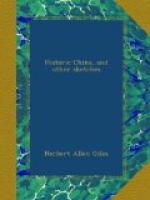of punishment, which may be used severely enough for
all practical purposes while it does not endanger life.
The Emperor K’ang Hsi, whose name is inseparably
connected with one of the most valuable lexicons that
have ever been compiled, forbade bambooing across
the upper part of the back and shoulders. “Near
the surface,” said this benign father of his
people, “lie the liver and the lungs. For
some trivial offence a man might be so punished that
these organs would never recover from the effects
of the blows.” The ruling system of bribery
has taken away from the bamboo its few remaining terrors
for those whose means are sufficient to influence the
hand which lays it on. Petty offences are chiefly
expiated by a small payment of money to the gaoler,
who lets the avenging bamboo fall proportionately
light, or assists the culprit by every means in his
power to shirk the degradation and annoyance of a
week in the cangue.[*] These two are the only ordinary
punishments we hear much about; torture, properly so
called, is permitted under certain circumstances, but
rarely if ever practised.
[*] A heavy wooden collar,
taken off at night only if the sentence is
a long one, or on payment
of a bribe.
In further support of this most heterodox position, we beg to offer a translation of two chapters from “Advice to Government Officials,” a native work of much repute all over the Empire:—
“CHAPTER V.
“The infliction of the bamboo is open to abuse in various ways. For instance, the knots in the wood may not have been smoothed off; blows may be given inside the joints, instead of above the knees; the tip end instead of the flat of the bamboo may be used; each stroke may be accompanied by a drawing movement of the hand, or the same spot may be struck again after the skin has been broken, whereby the suffering of the criminal is very much increased. Similarly, the ‘squeezing’ punishment depends entirely for its severity on the length of the sticks employed, whether these are wet or dry, as well as upon the tightness of the string. Such points should be carefully looked to by the magistrate himself, and not left to his subordinates. At the time of infliction still greater precautions should be taken to prevent the possibility of any accident, and where the offence was committed under venial circumstances, some part of the punishment may be remitted if it is considered that enough has already been inflicted. Such punishments as pressing the knees to the ground, making prisoners kneel on chains, or burning their legs with hot irons, adopted under the specious pretence of not using the ‘squeezing’ torture, are among the most barbarous of prohibited practices, and are on no account to be allowed.”
“CHAPTER VI.




